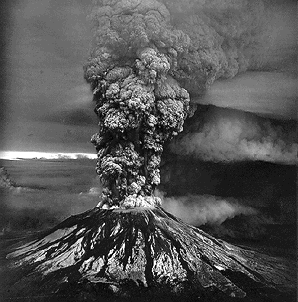Lecture 17 - Earth's Interior (11/10/98)
 Earth's Atmosphere --- | ---
Moon & Mercury
Earth's Atmosphere --- | ---
Moon & Mercury


Reading:
Chapter 2-1, 4-3 (ZG4)
Mount St. Helens eruption, May 18, 1980. (Courtesy USGS,
Austin Post)
 |
Key Question: |
What determines the run of
pressure with radius in a planet or star?
|
|---|
 |
Key Principle: |
Hydrostatic Equilibrium
|
|---|
 |
Key Problem: |
Calculate the central pressure of
the Earth.
|
|---|
 |
Key Quote: |
"Pressing down on you ...
Under Pressure" - D. Bowie
|
|---|
Investigations:
- Hydrostatic Equilibrium
- What is the equation of hydrostatic equilibrium? When can
we use it?
- What is the equation of mass continuity?
- An atmosphere at constant temperature implies what pressure scaling?
- An ocean at constant density and gravity implies what pressure
scaling?
- An interior at constant pressure but spherical symmetry and self
gravity implies what pressure scaling?
- What is the integral equation for the pressure as a function of
radius?
- What is the boundary condition at the surface of the Earth?
- How do we estimate the central pressure of the Earth?
- What would the central temperature of a just-formed Earth or
star be?
- Why is the central temperature of our Earth only 3000 K or so?
- What is the equation of state and why is this equation
necessary to solve the hydrostatic equilibrium in the general case?
- The Earth's Surface and Interior
- What are the mean densities of the Earth's crust,
mantle, and core?
- What type of minerals make up the bulk of the crust and mantle?
- How thick is the crust? The mantle?
- What is the pressure at the base of the crust?
- What happens when the crustal plates move on the
upper mantle?
- What are rifts, faults, and subduction zones?
- Where do volcanoes commonly form?
- Where does basalt come from? Where can it be found?
- What are examples of endogenic and exogenic processes?
- Did the Earth's water come from impacts from comets?
- How can you use interferometry of astronomical objects to measure
the crustal dynamics on of the Earth?
Volcanology, Plate Tectonics, and Geophysics
 Prev Lecture ---
Prev Lecture ---
 Next Lecture ---
Next Lecture ---
 Astr11 Index ---
Astr11 Index ---
 Astr11 Home
Astr11 Home
smyers@nrao.edu
Steven T. Myers
 Earth's Atmosphere --- | ---
Moon & Mercury
Earth's Atmosphere --- | ---
Moon & Mercury

 Earth's Atmosphere --- | ---
Moon & Mercury
Earth's Atmosphere --- | ---
Moon & Mercury






 Prev Lecture ---
Prev Lecture ---
 Next Lecture ---
Next Lecture ---
 Astr11 Index ---
Astr11 Index ---
 Astr11 Home
Astr11 Home